We are back on traditional ground as from 1873 to 1973 Holland America ships were in and out of this port on a daily basis. Not always in the most easy way as in the early years the depth of the river was not kept up with the vast increase in size and draft of the ships but eventually it was all sorted out.
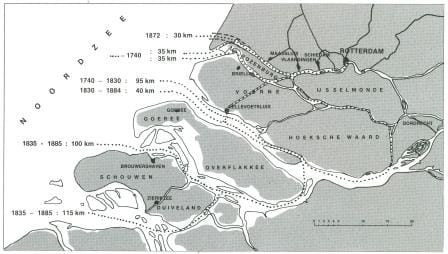
This chartlet shows the various routes to Rotterdam. As rule of thumb the deeper the draft the more southerly route you had to use until 1873.
The water we float on is the water of the river Maas (Dutch) or Meuse (French) and consists of rain water coming all the way from France and while running through Belgium and the Netherlands it is getting bigger and bigger. Before it looked as it does now, the river split up once it came to Holland or the Netherlands which was barely above water in those days. The area was a sort of Delta and the river split up in various smaller streams. Creating many little exits to the sea and all very shallow. Nothing could to be done about it; it was the way it was. When Amsterdam received a direct connection with the North Sea (the North Sea Canal) in the 1850’s, Rotterdam felt entitled to have that as well. So for the next 20 years they bombarded the government in The Hague with plans and complaints about them being left behind.
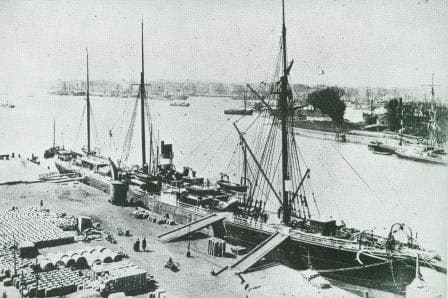
One of the new deep drafted ships which benefited from the New Waterway was the P. Caland. Named after the designer/ main engineer of this New Waterway. Holland America was so grateful for the direct connection that they named a ship after him. This was before the company went to DAM names only.
Then finally funding became available to straighten one arm of the Maas and being the Dutch way we gave it another name: the New Waterway. Based on this New Waterway plan it was decided to launch a steamship company but as a private enterprise called Plate & Reuchlin C.V named after the two main owners. They bought two new ships, the Rotterdam (I) and the Maas and then found that the river was still too shallow. So the ships had to go via the islands of Zeeland to get to Rotterdam via the backdoor. Extra costs and delays were the result. Then in 1873 the Nieuwe Waterweg /New Waterway was finally that far that deep sea steamships could make it to Rotterdam directly. At the same time the company went public to raise money for fleet expansion and thus we were officially born on 18 April 1873.
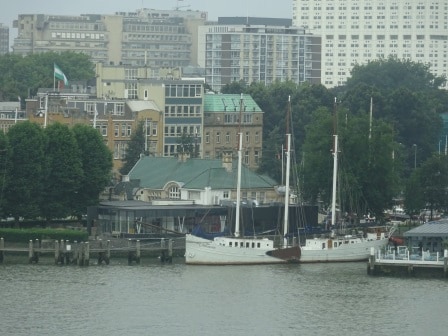
From the bridge of the ms Rotterdam looking to Starboard ,the north side of the river. Our first office in 1871. (The low building with the green roof)
The river side has changed enormously. Where there used to be only farm fields there is now industry and lots of Apartment buildings, as many of the small towns along the river are now more or less connected and form one big chain of Suburbia. Coming close to the passenger terminal, the layout of the city and the port has not changed very much but with the coming of Containerization for freight transportation the old docks have lost their commercial purpose and are now being redeveloped for housing.
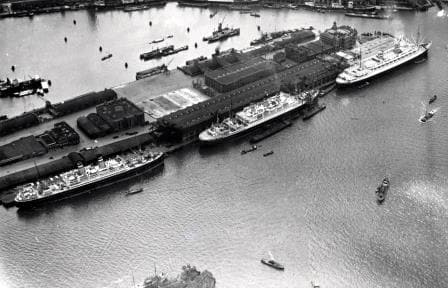
The Holland Amerika Lijn Terminal in the 1930’s. From Right to Left: ss Nieuw Amsterdam (II), ss Statendam (II) and either the Veendam or Volendam from 1922.
Once you have docked at the Cruise terminal you are in the heartland of Holland America. The current cruise terminal (about 50% of the old building it is still left) was built by the company after the 2nd world war when the first terminal was bombed. The parking areas and the apartment buildings around it now stand where once the cargo sheds of the company were. Our old head office (built between 1901 and 1909) still stands on the end of the pier and is now a hotel. Holland America has a sales and manning office in one of the large apartment buildings opposite. From the end of the pier you can also see the very old head office of the company (1871), the next office (Poortgebouw 1881) and in the distance the imposing silhouette of the Rotterdam V which is now a hotel, conference centre and museum.
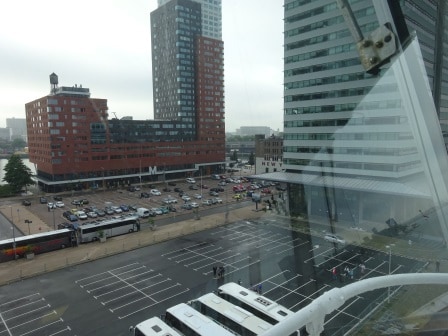
From the Bridge of the ms Rotterdam looking to Portside. In the brown building is where the Dutch office of HAL is located and next to it the old head office of the company now Hotel New York.
The area is a sort of triangle sticking out into the river. Where we are now docked was always the passenger side and as many as 3 passenger ships could be dock there at the same time. The other side (Rijnhaven) is where the cargo ships used to dock. Now it is open water or in use by river barges. At the corner, next to the old head office is a water taxi station, which takes you for 5 euro’s to the ss Rotterdam or into town. Cheaper than a taxi and much more fun.
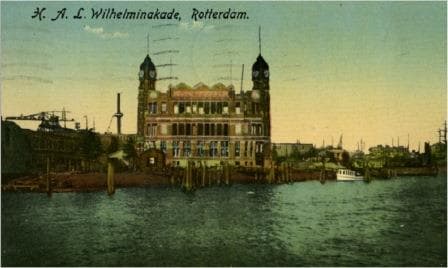
Our Dutch Head office in the Good old days. The little white boat is the special tender for transporting the company management through the port. It had the name: Dam.
I will have to take a regular taxi to Rotterdam Central Station as they dammed a long time ago the canal which ran all the way up it to the Central Station area, so no chance of taking a boat. From there I will take the local train to Amsterdam and my next blog will be tomorrow from the Koningsdam.
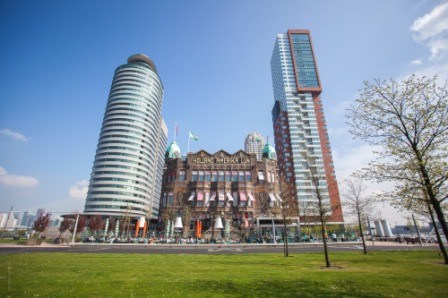

August 6, 2016 at 12:29 pm
We were thrilled to stay in the hotel in 2011, before embarking on the Rotterdam to celebrate our 30th wedding anniversary. We also renewed our wedding vows during the cruise. We have fond memories of the Rotterdam.
August 7, 2016 at 8:52 am
Great fun reading about the east bound portion of the Voyage of the Vikings. We are booked for the 2017 version of this cruise next September. Thanks to your blog, we know much more about it than before.
Thank you again for your posts. I have been reading them faithfully for the past several years and I appreciate your work and your writing very much.
August 7, 2016 at 3:49 pm
Thanks for sharing we loved to read all of your stories and certainly are going to make this voyage too!!